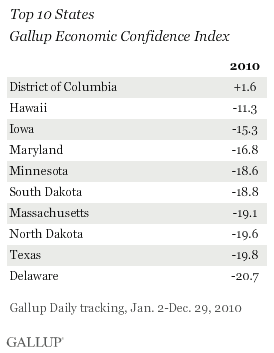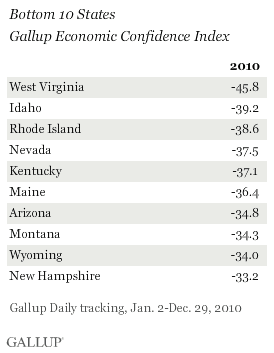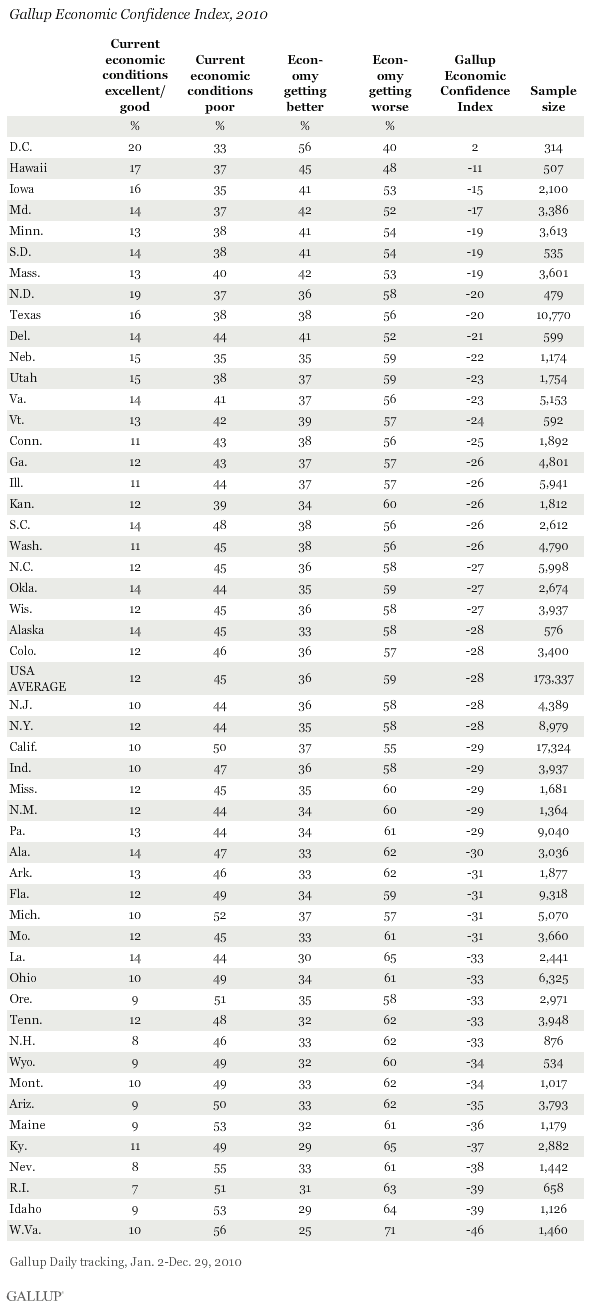PRINCETON, NJ -- While no state exhibited strong economic confidence in 2010, the people of Washington, D.C., Hawaii, Iowa, and Maryland had the highest economic confidence. At the other end of the spectrum, residents of West Virginia, Idaho, and Rhode Island were the least confident.


The Gallup Economic Confidence Index is a composite of two questions about the U.S. economy. One asks Americans to rate current economic conditions in the country -- as excellent, good, only fair, or poor. The other asks Americans whether they perceive that economic conditions are getting better or getting worse. The Index has a theoretical maximum of +100 (if all respondents rate the economy "excellent" or "good" and say it is improving) and a theoretical minimum of -100 (if all rate the economy "poor" and say it is getting worse).
Nationally, the Gallup Economic Index improved considerably over the past two years, increasing to -28 in 2010 from -35 in 2009 and -50 in 2008. However, it remains far below the strongly positive values recorded from the late 1990s through 2000.
The states with the highest economic confidence cluster in the center of country and, to a lesser degree, in the East. Several of these states (North Dakota, South Dakota, Nebraska, Hawaii, and Maryland) enjoy below-average unemployment rates. However, unemployment is not a perfect predictor of economic confidence, as several other states with relatively low unemployment (such as New Hampshire and Wyoming) have average or below-average confidence.

Confidence Up in Most States, but Particularly in Blue States
Between 2009 and 2010, economic confidence grew in 34 states plus the District of Columbia. The Gallup Economic Confidence Index increased in these states by at least 4 percentage points but by as much as 22 points. The Index was statistically unchanged in the remaining 16 states, all of which showed smaller increases or slight, but statistically insignificant, declines.
 |
| Explore complete state data > |
Six of the 10 states with the biggest gains in economic confidence in 2010 also rank in the top 10 Democratic states for the year: Hawaii, the District of Columbia, Delaware, Massachusetts, Maryland, and Connecticut.
Similarly, seven of the most Republican states -- South Dakota, New Hampshire, Idaho, Alaska, Utah, Montana, and Nebraska -- are among those showing no gains in economic confidence in 2010. As is the case for overall economic confidence, Rhode Island stands out as a state that does not follow expected partisan patterns, being the only top 10 Democratic state to show no improvement in confidence since 2009.
These political patterns in economic confidence trends among states were also evident in 2009, a finding Gallup credited at the time to the new Obama administration's boosting the economic outlook of Democrats and, conversely, discouraging that of Republicans.

Bottom Line
Although economic confidence improved in most states in 2010, the difference between the highest- and the lowest-confidence states remains a matter of degrees of economic pessimism, with only the District of Columbia showing net optimism. Furthermore, economic confidence rose by more than 10 points in only a handful of states, with residents in many of these possibly reacting positively to the president's leadership rather than to measurable economic gains.
Survey Methods
Results are based on telephone interviews conducted as part of Gallup Daily tracking Jan. 2-Dec. 29, 2010, with a random half sample of 173,337 adults, aged 18 and older, living in all 50 U.S. states and the District of Columbia, selected using random-digit-dial sampling.
For results based on the total sample of national adults, one can say with 95% confidence that the maximum margin of sampling error is ±1 percentage point.
The margins of error are no greater than ±7 percentage points for any state, and are ±4 points or less for most states. The margin of error for the District of Columbia is ±9 percentage points.
Interviews are conducted with respondents on landline telephones and cellular phones, with interviews conducted in Spanish for respondents who are primarily Spanish-speaking. Each daily sample includes a minimum quota of 200 cell phone respondents and 800 landline respondents, with additional minimum quotas among landline respondents for gender within region. Landline respondents are chosen at random within each household on the basis of which member had the most recent birthday.
Samples are weighted by gender, age, race, Hispanic ethnicity, education, region, adults in the household, cell phone-only status, cell phone-mostly status, and phone lines. Demographic weighting targets are based on the March 2010 Current Population Survey figures for the aged 18 and older non-institutionalized population living in U.S. telephone households. All reported margins of sampling error include the computed design effects for weighting and sample design.
In addition to sampling error, question wording and practical difficulties in conducting surveys can introduce error or bias into the findings of public opinion polls.
For more details on Gallup's polling methodology, visit www.gallup.com.

